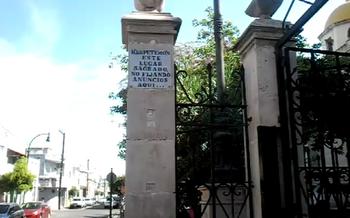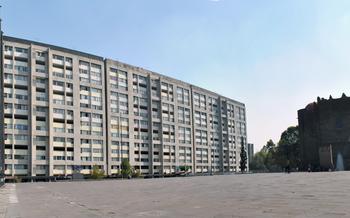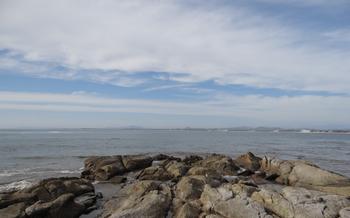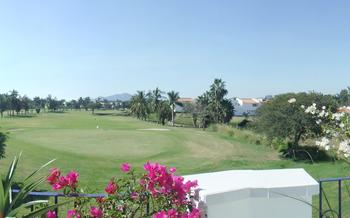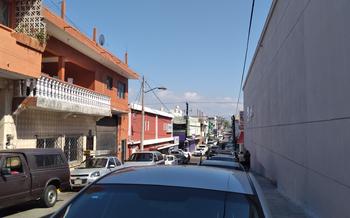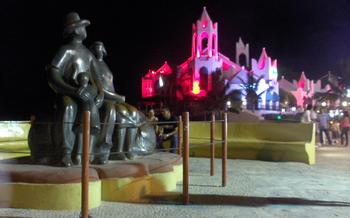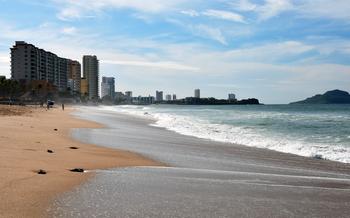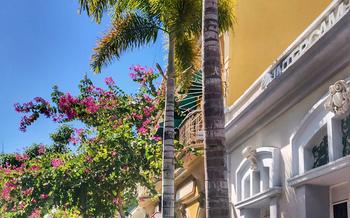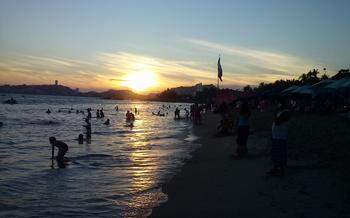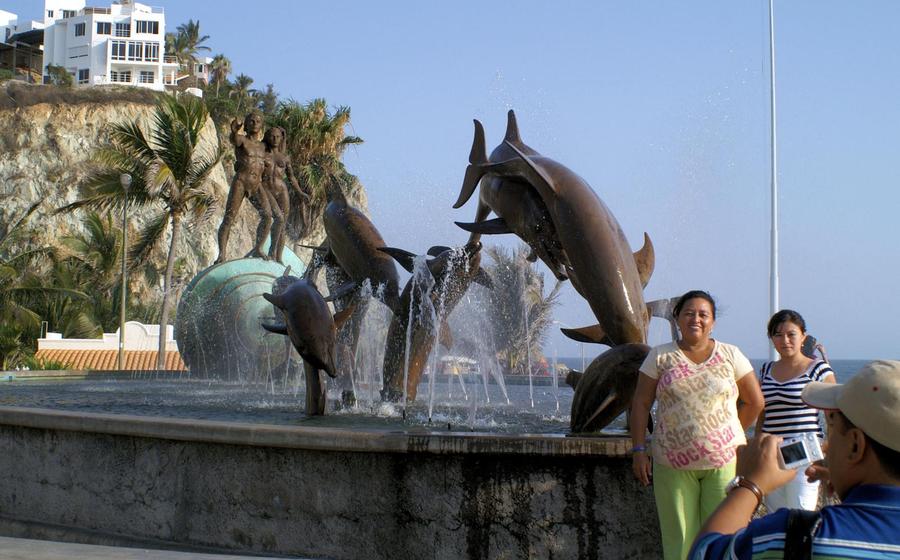
Monument to the Continuity of Life
- The Monument to the Continuity of Life: A Unique Symbol
- Location: Where to Find the Monument
- History: Uncovering the Past
- Symbolism: Interpreting the Message
- Architecture: Exploring the Design
- Artistic Significance: A Masterpiece of Modern Art
- Cultural Identity: A Symbol of Mazatlan
- History of the Monument: Unveiling Its Past
- The Sculpture's Design: Exploring Its Symbolism
- The Artist's Vision: Interpreting Its Meaning
- Historical Significance: A Landmark of Mazatlan
- Cultural Symbolism: Embracing Local Identity
- Artistic Techniques: Exploring Form and Expression
- Interactive Engagement: Encouraging Public Participation
- Insider Tip: Unveiling Hidden Details
The Monument to the Continuity of Life: A Unique Symbol
The Monument to the Continuity of Life, a sculpture by Mexican artist Carlos Espino, is a striking and iconic landmark located in Mazatlan, Mexico. It stands as a symbol of the city's rich cultural heritage and its enduring spirit. The monument was created in 1958 at the request of the local government as a tribute to the fishermen who lost their lives in the tragic sinking of the fishing boat "El Tiburon." Through its powerful imagery and symbolic representation, the monument serves as a poignant reminder of the fragility of life and the importance of unity in the face of adversity.
Location: Where to Find the Monument
The Monument to the Continuity of Life stands proudly on the Paseo Claussen, a picturesque seaside promenade that offers stunning views of the Pacific Ocean. The monument is conveniently located within walking distance of the city center and other popular tourist attractions in Mazatlan. Visitors can easily reach the monument on foot, by taking a leisurely stroll along the scenic promenade. Alternatively, they can opt for public transportation, with several bus lines running along the Paseo Claussen. For those arriving by car, there is ample parking available nearby, making it a convenient destination for visitors. The monument is also wheelchair accessible, ensuring that all visitors can enjoy this remarkable work of art.
History: Uncovering the Past
The Monument to the Continuity of Life was built in 1987, at the initiative of the Municipal Government of Mazatlan, which commissioned it to the renowned Mexican sculptor, Javier Marín. The creation of the monument was part of a broader urban renewal project aimed at beautifying the city and enhancing its cultural identity.
Marín was inspired to create the monument by the rich history and vibrant culture of Mazatlan. He sought to capture the essence of the city's past, present, and future, and to create a symbol that would represent the continuity of life and the resilience of the human spirit.
The monument was unveiled on November 20, 1987, and quickly became a beloved landmark of Mazatlan. It has since undergone several renovations and restorations, ensuring its preservation for future generations.
Symbolism: Interpreting the Message
The Monument to the Continuity of Life is a powerful symbol of the enduring spirit of Mazatlan and its people. Each element of the monument holds deep meaning, contributing to its overall message of unity, resilience, and the interconnectedness of all living things.
The central figure of the monument, a woman with her arms outstretched, represents the continuity of life. Her stance, with one foot firmly planted on the ground and the other reaching towards the sky, symbolizes the connection between the earthly and spiritual realms. The woman's open arms embrace the surrounding figures, representing the community's unity and support.
The surrounding figures, each engaged in different activities, symbolize the diverse aspects of human existence. They represent the interconnectedness of all people, regardless of their race, gender, or background. The figures' hands are intertwined, forming a chain that reinforces the idea of unity and cooperation.
The monument's base, adorned with intricate carvings, depicts scenes from Mazatlan's history and culture. These carvings serve as a reminder of the city's rich heritage and the struggles and triumphs that have shaped its identity. The base also features a series of fountains, representing the life-giving waters that sustain and nourish the community.
Overall, the Monument to the Continuity of Life is a powerful symbol of Mazatlan's spirit and its people's resilience and unity. It is a reminder of the interconnectedness of all living things and the importance of working together to build a better future.
Architecture: Exploring the Design
The monument is composed of three distinct sections. The base is a circular platform made of concrete and covered in ceramic tiles. It represents the earth and the foundation of human life. The second section is a series of interlocking bronze rings that symbolize the continuity of life. The rings are suspended from the base and appear to float in the air. The third section is a bronze sculpture of a human figure that stands on top of the rings. The figure represents the spirit of life and the connection between humanity and the divine.
The monument is a unique and striking work of art. It is a combination of modern and traditional elements that comes together to create a powerful and moving statement about the beauty of life and the enduring human spirit.
Artistic Significance: A Masterpiece of Modern Art
The Monument to the Continuity of Life is widely regarded as a significant work of modern art. Its unique and striking design has garnered critical acclaim, and it is considered a masterpiece of Mexican sculptor Jorge Dubon. Dubon's artistic style is characterized by its expressive use of form and symbolism, and the monument is a prime example of his talent. The monument's innovative and thought-provoking design has made it a beloved landmark and a must-see for art enthusiasts visiting Mazatlan.
Compared to other works by Dubon, the monument stands out for its ambitious scale and complexity. It is one of his largest and most intricate sculptures, and its unique form and composition set it apart from his other creations. The monument's distinctive shape and its use of negative space create a visually dynamic and engaging work of art that captivates viewers from all angles.
One of the most striking features of the monument is its ability to evoke a range of emotions and interpretations. Its abstract form and symbolic elements allow viewers to bring their own experiences and perspectives to the work, creating a deeply personal and subjective experience. The monument's ability to resonate with viewers on a personal level is a testament to its artistic power and its enduring appeal.
The Monument to the Continuity of Life has influenced countless other artists and movements, both in Mexico and beyond. Its innovative design and symbolic content have inspired a new generation of artists to explore the possibilities of abstract sculpture and to push the boundaries of artistic expression. The monument's legacy as a groundbreaking work of modern art continues to inspire and challenge artists to this day.
Cultural Identity: A Symbol of Mazatlan
The Monument to the Continuity of Life has become a symbol of Mazatlan, representing its rich culture and unique identity. It has played a significant role in promoting the city's tourism industry, attracting visitors from around the world to witness this iconic masterpiece. Local residents have embraced the monument as a symbol of their community, a source of pride and a testament to their cultural heritage. It has become an integral part of the city's identity, contributing to its distinct sense of place and making it a truly special destination.
History of the Monument: Unveiling Its Past
The Monument to the Continuity of Life was built in 1965, during the presidency of Adolfo López Mateos. It was commissioned by the Mazatlan City Council as a symbol of the city's growing tourism industry and its commitment to cultural development. The monument was designed by Mexican artist Enrique Carbajal, also known as Sebastián, who was inspired by the beauty of the Mazatlan coastline and the city's rich history.
The construction of the monument faced several challenges, including the transportation of the massive bronze sculptures from Mexico City to Mazatlan. The sculptures were so heavy that they had to be transported on a special barge, and the journey took several weeks. Once the sculptures arrived in Mazatlan, they were assembled on the site of the monument, which was located on the city's waterfront, facing the Pacific Ocean.
The Sculpture's Design: Exploring Its Symbolism
The Monument to the Continuity of Life is a remarkable work of art that captivates viewers with its intricate design and profound symbolism. The sculpture is crafted from bronze, a durable material that has withstood the test of time and the harsh coastal environment of Mazatlan. The artist employed various techniques, including casting, welding, and patination, to achieve the sculpture's unique form and texture.
The sculpture's shape is both abstract and organic, resembling a continuous loop or spiral. This form symbolizes the cyclical nature of life, death, and rebirth, a theme that is central to the monument's message. The sculpture's spiral form also evokes the idea of infinity, suggesting that the cycle of life is endless and interconnected.
The composition of the sculpture further reinforces its symbolic meaning. The central figure, a human form, is depicted as emerging from the earth, representing the beginning of life. The figure's arms reach upward, symbolizing aspiration and growth. Surrounding the human form are various marine creatures, such as fish, turtles, and dolphins, which represent the diversity and interconnectedness of life in the sea.
The sculpture's placement on a rocky outcrop overlooking the Pacific Ocean adds to its symbolic significance. The ocean, a vast and powerful force of nature, serves as a reminder of the fragility and transience of human life. The monument's position, facing the vastness of the ocean, invites viewers to contemplate the interconnectedness of all living things and the eternal cycle of existence.
The Artist's Vision: Interpreting Its Meaning
The Monument to the Continuity of Life was created by Mexican artist Carlos Espino. Espino is known for his large-scale sculptures that explore themes of human unity, cultural diversity, and the interconnectedness of all living things. He is a master of bronze casting, a technique that allows him to create intricate and detailed forms.
Espino's vision for the monument was to create a symbol of hope and renewal for the people of Mazatlan. He wanted to create a work of art that would inspire them to come together and work towards a better future. The monument's central figure is a woman holding a baby in her arms, representing the continuity of life and the hope for a brighter future.
The artist's intention was to convey a message of unity and hope for the people of Mazatlan, Mexico. He believed that the sculpture would serve as a reminder of the interconnectedness of all living beings and the importance of working together to build a better future. Espino's hope was that the sculpture would inspire viewers to reflect on their own lives and the role they can play in creating a more harmonious and just world.
Historical Significance: A Landmark of Mazatlan
The Monument to the Continuity of Life is a historically significant landmark in Mazatlan, recognized for its profound impact on the city's development. Erected in 1978, the monument was commissioned by the Mazatlan City Council as a testament to the city's rich history and unwavering spirit. The monument's creation was inspired by the city's resilience in the face of adversity, particularly its ability to bounce back from natural disasters and economic challenges. Over the years, the monument has become a symbol of Mazatlan's strength, determination, and ability to continuously reinvent itself.
Significant efforts have been made to preserve and protect this iconic landmark. In 2000, the monument underwent a comprehensive restoration project to ensure its longevity and maintain its original grandeur. The restoration process involved cleaning and repairing the monument's exterior, as well as reinforcing its structure to withstand the elements. Today, the monument stands as a testament to the enduring legacy of Mazatlan, serving as a reminder of its rich history and inspiring generations to come.
Cultural Symbolism: Embracing Local Identity
The Monument to the Continuity of Life is a powerful symbol of Mazatlan's unique identity. It incorporates cultural symbols and motifs that resonate with the local community. The sculpture's central figure, a woman with outstretched arms, represents the city's embrace of diversity and its welcoming spirit. The surrounding figures, each representing a different aspect of Mazatlan's culture, celebrate the city's rich traditions, beliefs, and values. The monument serves as a reminder of the city's deep-rooted history and its vibrant cultural heritage. It is a source of pride for local residents and a symbol of unity and belonging. The monument has been used to promote and celebrate Mazatlan's cultural heritage, both locally and internationally, contributing to the city's unique identity and sense of place.
Artistic Techniques: Exploring Form and Expression
The artist of the Monument to the Continuity of Life employed a variety of artistic techniques to create its distinctive form and convey its powerful message. The sculpture's dynamic composition, characterized by its upward-reaching spirals and interwoven figures, creates a sense of movement and energy that draws the viewer's eye. The artist's skillful use of materials, textures, and colors further enhances the sculpture's visual impact. The smooth, polished surfaces of the bronze figures contrast with the rough, textured base, creating a tactile experience that invites viewers to explore the sculpture's intricate details. The artist's intentional use of light and shadow adds depth and dimension to the sculpture, revealing hidden forms and textures that change throughout the day as the sun's position shifts. These carefully considered artistic techniques work together to create a visually striking and emotionally resonant work of art that invites viewers to contemplate its deeper meanings and significance.
Interactive Engagement: Encouraging Public Participation
The Monument to the Continuity of Life is not just a passive work of art to be admired from a distance. It actively invites visitors to engage with it, fostering a deeper connection and understanding. Its interactive nature adds another dimension to the experience, making it more memorable and meaningful. Visitors are encouraged to walk around the monument, observing it from different angles and perspectives. The monument's open and accessible design allows visitors to get up close and personal with the sculpture, appreciating its intricate details and textures. Some elements of the sculpture are designed to be touched and explored, inviting visitors to interact with the artwork in a tactile way. This interactive aspect not only enhances the visitor's experience but also reinforces the monument's message of unity and interconnectedness, encouraging a sense of participation and ownership.
Insider Tip: Unveiling Hidden Details
When exploring the Monument to the Continuity of Life, take the time to discover the hidden details and symbols that add depth and intrigue to the sculpture. Look closely at the base of the monument, where you may find intricate carvings or inscriptions that provide clues to its history and meaning. Observe the way the light interacts with the sculpture at different times of the day, as the changing shadows can reveal new perspectives and dimensions. Local residents may share legends or stories associated with the monument, offering a glimpse into its cultural significance. Delve deeper into the artist's background and influences to uncover the inspiration behind the design and the messages it conveys. By uncovering these hidden details, you'll gain a richer understanding and appreciation for this remarkable work of art.
